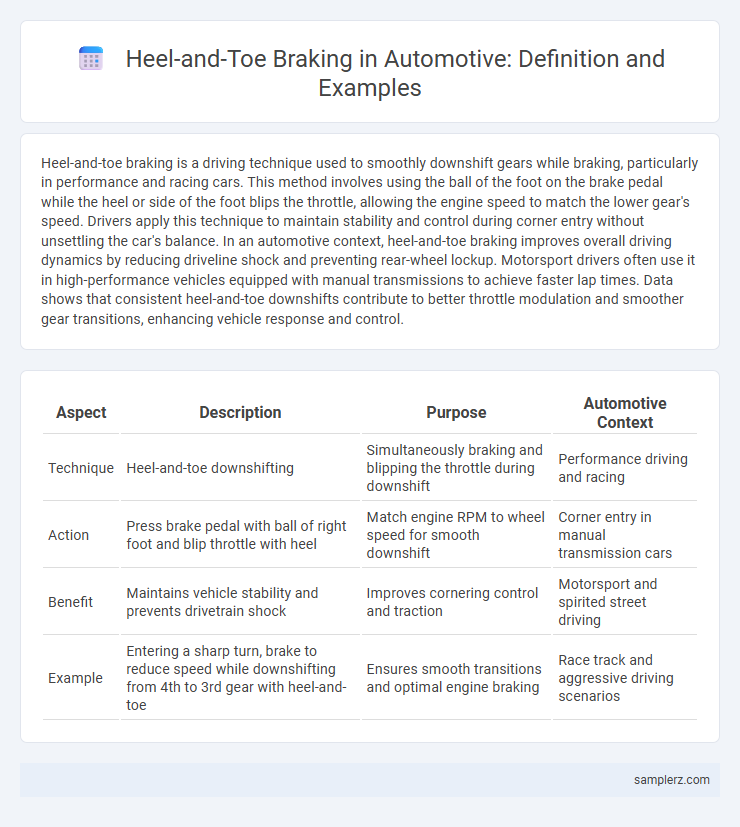Heel-and-toe braking is a driving technique used to smoothly downshift gears while braking, particularly in performance and racing cars. This method involves using the ball of the foot on the brake pedal while the heel or side of the foot blips the throttle, allowing the engine speed to match the lower gear's speed. Drivers apply this technique to maintain stability and control during corner entry without unsettling the car's balance. In an automotive context, heel-and-toe braking improves overall driving dynamics by reducing driveline shock and preventing rear-wheel lockup. Motorsport drivers often use it in high-performance vehicles equipped with manual transmissions to achieve faster lap times. Data shows that consistent heel-and-toe downshifts contribute to better throttle modulation and smoother gear transitions, enhancing vehicle response and control.
Table of Comparison
| Aspect | Description | Purpose | Automotive Context |
|---|---|---|---|
| Technique | Heel-and-toe downshifting | Simultaneously braking and blipping the throttle during downshift | Performance driving and racing |
| Action | Press brake pedal with ball of right foot and blip throttle with heel | Match engine RPM to wheel speed for smooth downshift | Corner entry in manual transmission cars |
| Benefit | Maintains vehicle stability and prevents drivetrain shock | Improves cornering control and traction | Motorsport and spirited street driving |
| Example | Entering a sharp turn, brake to reduce speed while downshifting from 4th to 3rd gear with heel-and-toe | Ensures smooth transitions and optimal engine braking | Race track and aggressive driving scenarios |
Introduction to Heel-and-Toe Braking Technique
Heel-and-toe braking is a driving technique used to smoothly downshift while braking, allowing drivers to maintain stability and control during cornering. This technique involves using the ball of the foot to press the brake pedal while simultaneously using the heel or side of the foot to blip the throttle, matching engine RPM to the lower gear's speed. It is commonly employed in performance driving and motorsports to prevent drivetrain shock and maintain optimal traction through turns.
Importance of Heel-and-Toe in Performance Driving
Heel-and-toe braking enhances performance driving by allowing smooth downshifts while maintaining vehicle stability, preventing rear-wheel lockup during deceleration. This technique optimizes engine rev-matching, which improves corner entry speed and preserves tire traction on high-performance vehicles. Mastery of heel-and-toe is crucial for precise control in competitive racing and spirited driving scenarios.
Step-by-Step Guide to Heel-and-Toe Downshifting
Heel-and-toe downshifting is a driving technique used in performance and racing to match engine speed with transmission speed during braking. Begin by applying the brake with the ball of the right foot while blipping the throttle with the heel to raise engine RPM before downshifting; simultaneously, use the left foot to operate the clutch, allowing smooth, synchronized gear transitions. This technique prevents rear wheel lockup, maintains vehicle stability, and enhances cornering performance.
Common Mistakes in Heel-and-Toe Application
Common mistakes in heel-and-toe braking include improper throttle blipping, leading to engine lugging or over-revving, and poor heel placement causing delayed or uneven brake modulation. Drivers often fail to synchronize brake and throttle inputs smoothly, resulting in jerky downshifts that compromise vehicle stability and tire grip. Mastery of heel-and-toe technique requires precise timing and foot positioning to maintain engine speed alignment with transmission during aggressive corner entry.
Real-World Example: Heel-and-Toe in Track Racing
In track racing, heel-and-toe braking enables drivers to simultaneously brake and downshift, maintaining engine revs and vehicle stability through corners. A prime example is during a tight hairpin turn, where precise heel-and-toe technique allows racers to brake late while smoothly transitioning to a lower gear without upsetting the car's balance. Professional drivers like those in GT and touring car championships use heel-and-toe to optimize lap times and improve traction under heavy braking conditions.
Benefits of Mastering Heel-and-Toe for Braking
Mastering heel-and-toe braking enhances car control by allowing smooth downshifts and maintaining engine stability during deceleration, especially in high-performance driving scenarios. This technique minimizes brake fade and prevents rear-wheel lockup, improving overall safety and vehicle responsiveness. Skilled application of heel-and-toe reduces tire wear and optimizes lap times on racetracks by enabling precise throttle modulation while braking.
Heel-and-Toe vs. Standard Braking Methods
Heel-and-toe braking technique enables smoother gear transitions during aggressive driving by simultaneously operating the brake and throttle, enhancing vehicle control in corners. Standard braking methods typically involve simply pressing the brake pedal to decelerate, which can lead to less balanced weight distribution and potential loss of traction. In comparison, heel-and-toe optimizes engine speed and brake pressure coordination, resulting in improved stability and faster lap times on track conditions.
Training Exercises for Heel-and-Toe Proficiency
Heel-and-toe training exercises involve practicing coordinated braking and throttle control to optimize vehicle stability during downshifting. Drivers repeatedly perform controlled downshifts while approaching corners on a closed course, emphasizing smooth rev-matching and seamless pedal transitions. Consistent drills improve muscle memory and precision, essential for mastering heel-and-toe braking in high-performance driving scenarios.
Vehicle Setup Tips for Effective Heel-and-Toe
Ensuring optimal pedal spacing and adjustable brake bias enhances the effectiveness of heel-and-toe downshifting in performance driving. A firm, detachable brake pedal pad provides consistent grip while allowing smooth transition between brake and throttle. Fine-tuning suspension settings for balanced weight transfer supports stability during heel-and-toe maneuvers, maximizing control and responsiveness.
Tips for Practicing Heel-and-Toe on Public Roads
Mastering heel-and-toe braking on public roads requires smooth coordination between the brake and throttle pedals to maintain vehicle stability during downshifts. Practice in low-traffic areas with gentle turns to build muscle memory and avoid abrupt movements that can upset traction. Gradually increase speed and complexity as confidence grows, ensuring safe control and precise rev-matching for seamless gear transitions.

example of heel-and-toe in braking Infographic
 samplerz.com
samplerz.com